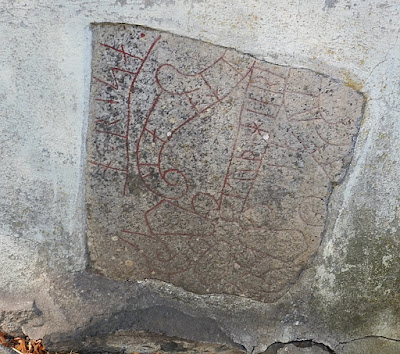目次 / Contents
1) 散策マップ / Walking Map
2) ルーン文字との出会い / Encounter with Rune
3) 最初のルーン石碑 / First Runestone
3) 最初のルーン石碑 / First Runestone
A. メインストリートから / From Main Street
B. 壁の中に / In the Wall
B. 壁の中に / In the Wall
 |
薄いオレンジ部分 : シグトゥーナ自治体
シグトゥーナ / Sigtuna はストックホルムの北に位置する、小さな町(村)ですが、 その名前が、シグトゥーナ自治体と同じなのは、 スウェーデンで最古の町だからでしょう。
Pale Orange Part : Sigtuna Municipality
Sigtuna is a small town (village) in the north of Stockholm,
with the same name as Sigtuna municipality,
画像は下記より / This from belowprobably because it is the oldest town in Sweden. ★ |
1) 散策マップ / Walking Map
シグトゥーナ / Sigtuna は、ヴァイキング時代(Viking Age / 793 - 1066)から、
中世時代の1200年頃まで100年以上に渡って栄えました。
シグトゥーナには、ヴァイキング時代に作られたと思われるルーン石碑が複数あり、町の散策マップにも記されています (下の画像)。
 散策マップ / Walking Map
私達はほぼこの範囲をルーン石碑を追って歩きました。
全ての ルーン石碑は見つけることができませんでした。
見つける必死さに欠けたところがあります(苦笑)。
We walked around this area following the Runestones.
We did not find all of the Runestones.
There was a lack of desperation to find (Wry smile).
Runic stones : Runestone : ルーン石碑
(博物館の資料 / Museum materials : ★)
"私たちのルーン文字の碑文はスウェーデン語で最も古く、
シグチューンほど多くを誇る町は他にありません。
ここでは、合計10個の完全な石と約20個の破片を見つけることができます。
ルーン石は、11世紀に親族を記念して建てられました。"
|
Walking Map
Sigtuna had flourished for over 100 years, from the Viking Age (793 - 1066) to the 1200s of the Middle Ages.
Sigtuna has Runestones that are believed to have been set up during the Viking Age and are also noted on the town walk map, above.
 |
シグトゥーナにあるルーン石碑の1つ
One of the Runestones in Sigtuna |
2) ルーン文字との出会い / Encounter with Runes
ルーン石碑(スウェーデン語: runsten、英: runestone)は、ルーン文字で碑文が刻まれた石碑です。
下記、ルーン文字についてWikiより
起源には諸説あるが、北エトルリア起源の北イタリア文字から借用したとする説が
有力である(エトルリア文字)。
有力である(エトルリア文字)。
私が初めて、'ルーン文字' と出合ったのは、ファンタジー小説・『ホビットの冒険』でした。
『ホビットの冒険 』
日本語版1965 / 訳:瀬田 貞二 (セタ テイジ / 1916 - 1979)
トールキン は言語学者で、彼が創作した言語も物語にありますが、'ルーン文字'は、'ルーン文字' として使用されています。
私にとって、'ルーン文字' は、古代の神秘的世界を想起させる、魅惑的な文字です。
ルーン石碑となると、さらに古いイメージがあり、その発見は、遺跡発掘に近い
喜びがあります。
喜びがあります。
 |
1937年初版の表紙
表紙も挿絵もトールキン自身がしています。 背表紙にルーン文字らしきものがデザインされています。 Cover of the 1937 First Edition Tolkien himself designed the cover and illustrated the whole book. The spine included a rune-like design. 画像は下記より / This from below ★ |
Encounter with Runes
It was in a fantasy novel, "The Hobbit" that I first encountered "Runes".
"The Hobbit "
[Original 1937 / J.R.R. Tolkien (1892 - 1973) /
Japanese version 1965 / Translated by Teiji Seta (1916 - 1979) /
Picture: Ryuichi Terashima (1918-2001) / Iwanami Shoten, Publisher]
Tolkien was a linguist and the new language he created is in the story, but he used 'Runes' as 'Runes'.
For me, the 'Runes' are fascinating letters that evoke the mysterious world of ancient times.
When it comes to the Runestone, being on stone has an even older image, and its discovery is like the joy of excavating ruins.
 |
ルーン文字
ベラム写本は、Codex Runicus (北欧の州法)として知られています。
全てルーン文字で書かれた1300年代の最古の
スカニア法(Skånske lov : 最古のデンマークの州法)であり、
最も保存状態の良い文章の1つです。
Runes
AM 28 8vo, known as Codex Runicus,
a vellum manuscript from c. 1300 containing one of the oldest
and best preserved texts of the Scanian law (Skånske lov),
written entirely in runes.画像は下記より / This from below ★ |
3) 最初のルーン石碑 / First Runestone
A. メインストリートから / From Main Street
メイン・ストリートのストラガタン通りから、最初のルーン石碑に向かいます。
その石碑は、聖マリア教会 / St. Mary's Church / Mariakyrkanの敷地にあります。
散策マップでは、4番に表示され、その周辺に3つのルーン石碑も表示されています。
メイン・ストリートのストラガタン通りから、最初のルーン石碑に向かいます。
その石碑は、聖マリア教会 / St. Mary's Church / Mariakyrkanの敷地にあります。
散策マップでは、4番に表示され、その周辺に3つのルーン石碑も表示されています。
From Main Street
From Stora Gatan Street, the main street, head to the first Runestone.
The Runestone is located on the site of St. Mary's Church / Mariakyrkan.
In the walking map, it is displayed as number 4, and three Runestones are also displayed around it.
The Runestone is located on the site of St. Mary's Church / Mariakyrkan.
In the walking map, it is displayed as number 4, and three Runestones are also displayed around it.
 |
| キルコガタン小道 メイン・ストリートのストラガタン通りから教会の敷地へ向かいました。 キルコガタン通りを進みます。 Kyrkogatan Path From Stora Gatan Street, a main street, we headed to the church grounds. Follow Kyrkogatan Street.  砂利が綺麗に手入れをされていて、日本の石庭を思い起こしました。 The gravel was well kept and reminded me of a Japanese rock garden. 
案内板
左上が聖マリア教会
左下に聖オーロフ教会 (の遺跡)
Guide Board
Upper left is St. Mary's Church.
St .Olofs Church (the ruins) in the lower left.
 聖オーロフ教会が木々の間に見えます。 The St. Olofs Church ( Sankt Olofs kyrkoruin) can be seen among the trees. 
聖マリア教会の入り口
この門の右側に聖マリア教会があり、
左側に聖オーロフ教会の遺跡があります。
Entrance of St Mary's Church
To the right of this gate is the St. Mary's Church and
on the left are the St. OlofsChurch Ruins.
|
B. 壁の中に / In the Wall
聖マリア教会の入り口前の左側に小さな建物 (下の画像) があり、これも聖マリア
教会の一部です。
教会の一部です。
ここで、見逃してはならないのは、壁に嵌め込まれたルーン石碑です。
To the left of the entrance to St. Mary's Church, there is a small building, below which is also part of the Church.
What you shouldn't miss here is the Runestone inset in the wall.
 |
| ベンチ左脇にルーン石碑が見えます。 You can see the Runestone on the left side of the bench.  私達がシグトゥーナで見た初めてのルーン石碑でした。 It was the first Runestone we saw in Sigtuna. |








0 件のコメント:
コメントを投稿